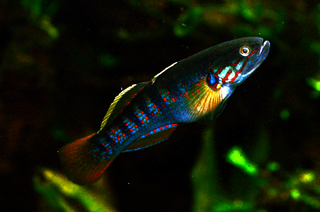
Eleotridae is a family of fish commonly known as sleeper gobies, with about 34 genera and 180 species. Most species are found in the tropical Indo-Pacific region, but there are also species in subtropical and temperate regions, warmer parts of the Americas and near the Atlantic coast in Africa. While many eleotrids pass through a planktonic stage in the sea and some spend their entire lives in the sea; as adults, the majority live in freshwater streams and brackish water. One of its genera, Caecieleotris, is troglobitic. They are especially important as predators in the freshwater stream ecosystems on oceanic islands such as New Zealand and Hawaii that otherwise lack the predatory fish families typical of nearby continents, such as catfish. Anatomically, they are similar to the gobies (Gobiidae), though unlike the majority of gobies, they do not have a pelvic sucker.
James Leonard Brierley Smith was a South African ichthyologist, organic chemist, and university professor. He was the first to identify a taxidermied fish as a coelacanth, at the time thought to be long extinct.
Collared wrigglers are perciform fishes in the family Xenisthmidae. They are native to the Indian and Pacific Oceans, where they are mostly reef-dwelling.

Scorpaena is a widespread genus of marine ray-finned fish belonging to the family Scorpaenidae, the scorpionfishes.

The South African Institute for Aquatic Biodiversity (SAIAB), is involved in research, education and in applications of its knowledge and research to African fish fauna, for either economic or conservation benefit.

The Dinopercidae, known commonly as the cavebasses, are a family of marine ray-finned fish from the perciform superfamily Percoidea. They are native to the western Indian and the Atlantic coasts of Africa.
Xenisthmus polyzonatus is a species of fish in the Xenisthmidae (wriggler) family, which is regarded as a synonymous with the Eleotridae... It is found in the Indo-Pacific, from the Red Sea to Samoa, north to the Ryukyu Islands.

Xenisthmus is the most well-known genus in the family Xenisthmidae, which is regarded as a synonymous with the Eleotridae, a part of Gobiiformes. These small to very small fish are known as wrigglers, and live in reefs and among rubble in the Indo-Pacific.
Xenisthmus balius is a species of fish in the Xenisthmidae (wriggler) family, which is regarded as a synonymous with the Eleotridae,. It is found in the Persian Gulf.

Xenisthmus clarus, better known as the clear wriggler, is a species of fish in the Xenisthmidae (wriggler) family, which is regarded as a synonymous with the Eleotridae.
Xenisthmus chi is a species of fish in the wriggler family, Xenisthmidae, which is regarded as a synonymous with the Eleotridae,. Japan wrigglers are tiny and clear. Before Paedocypris progenetica and the dwarf goby were discovered, the Japan wriggler was the smallest known fish.
Scorpaenodes minor, the minor scorpionfish or Brock's scorpionfish, is a species of venomous marine ray-finned fish belonging to the family Scorpaenidae, the scorpionfishes. This species is found in the Indian and Pacific Oceans.
Helcogramma ememes is a species of triplefin blenny in the genus Helcogramma. It was described by Wouter Holleman in 2007 who used the initials of his mentor Margaret Mary Smith (1916-1987) of the J.L.B. Smith Institute of Ichthyology to create this species specific name. Smith and her husband, J.L.B. Smith, had collected many specimens of this blenny in the 1960s. This species is found in the western Indian Ocean along the coats of East Africa from the Bazaruto Islands in Mozambique to Malindi in Kenya, it is also found in the Comoro Islands, Mauritius and the Seychelles.

Holocentrinae is a subfamily of Holocentridae containing 40 recognized species and one proposed species. Its members are typically known as squirrelfish and all are nocturnal. All three genera in the subfamily are found in the Atlantic and Holocentrus is restricted to this ocean. Most species in genera Neoniphon and Sargocentron are from the Indo-Pacific region and several of these occur in the Indian Ocean west of the southern tip of India.
Xenisthmus eirospilus, the spotted wriggler, is a species of fish in the wriggler family, Xenisthmidae, which is regarded as a synonymous with the Eleotridae,. It is distributed in the western Pacific from Middleton Reef and Ashmore Reef off Australia, West Papua, Indonesia, to Rotuma and Tonga. Its habitat is sand patches among reefs and rubble, as well as in shallow surge areas.
Xenisthmus semicinctus, the halfbelt wriggler, is a species of fish in the wriggler family, Xenisthmidae, which is regarded as a synonymous with the Eleotridae,.
John Ernest "Jack" Randall was an American ichthyologist and a leading authority on coral reef fishes. Randall described over 800 species and authored 11 books and over 900 scientific papers and popular articles. He spent most of his career working in Hawaii. He died in April 2020 at the age of 95.
Xenisthmus oligoporus, the few-pored wriggler, is a species of goby from the family Eleotridae. It is found in the Red Sea off Saudi Arabia.
Phillip Clarence Heemstra was an American-South African ichthyologist. He was born in Melrose Park, Illinois, United States as the son of Clarence William Heemstra and his wife, Lydia. He attended school in Ottawa, Illinois, and completed a B.Sc. Zoology in 1963 at the University of Illinois at Urbana, Illinois, as well as his MSc degree (1968) and doctorate (1974) in marine biology at the University of Miami in Miami, Florida. He moved to live in South Africa in 1978.

Argyrosomus hololepidotus, also known as the Madagascar meagre or southern meagre, is a species of marine ray-finned fish belonging to the family Sciaenidae, the drums and croakers. The species is endemic to Madagascar and the Indian Ocean.






